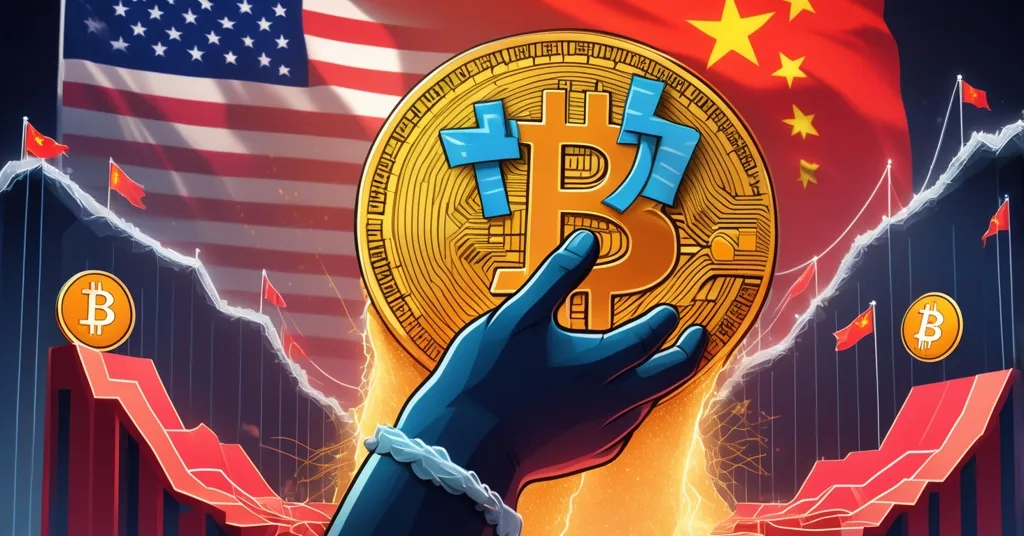Bitcoin Surges Past $115K as US-China Trade Tensions Ease and Markets Rally

Bitcoin Blasts Past $115K Amid US-China Trade Thaw and Market Optimism
Bitcoin has roared past $115,000 with a 3.6% surge on Monday, fueled by a wave of positive sentiment across global markets as signs of easing US-China trade tensions emerge. This rally, mirrored by gains in stocks and other cryptocurrencies, hints at a broader appetite for riskier investments, positioning digital assets as key players in a shifting financial landscape.
- Bitcoin Milestone: BTC jumps 3.6% to surpass $115,000.
- Crypto Market Boom: Total market cap rises 3.7% to $3.9 trillion.
- Trade Relief: Potential US-China deal sparks investor confidence.
- Institutional Push: Corporate and mining trends bolster crypto adoption.
Geopolitical Breakthrough: US-China Trade Deal in Focus
The catalyst behind much of this bullish momentum comes from international developments. Senior officials from the US and China have laid out a framework for a preliminary trade agreement, set for review by Presidents Donald Trump and Xi Jinping in South Korea. If finalized, this deal could halt escalating US tariffs and China’s threatened restrictions on rare earth exports—critical materials for tech industries. For context, trade tensions between these economic giants have rattled markets since 2018, with tariffs and retaliatory measures often dragging down risk assets, including cryptocurrencies. The 2019 phase one deal offered temporary relief, but unresolved issues kept investors on edge. Now, even a hint of de-escalation, as reported in recent updates on Bitcoin nearing $116K amid trade thaw signals, has markets buzzing with optimism, pushing capital into speculative plays like Bitcoin. Let’s keep our feet on the ground, though—a handshake doesn’t guarantee peace. One diplomatic blunder could flip this narrative, sending shockwaves back through financial systems. We’ve watched this blockbuster play out before, and the sequel might not have a happy ending.
US Economic Signals: Inflation Cools, Fed Rate Cut Looms
Domestically, the US economy is adding jet fuel to Bitcoin’s ascent. Inflation data for September showed the Consumer Price Index (CPI)—a measure of average price changes for goods and services—rising by just 3% year-on-year, below the expected 3.1%. Compared to the 9.1% peak in mid-2022, this slowdown signals a cooling economy, giving investors hope for looser monetary policy. Markets are now pricing in a 25 basis point (that’s 0.25 percentage points) interest rate cut by the Federal Reserve, lowering the benchmark rate from 4.0% to 4.25%. Why does this matter? Lower rates reduce borrowing costs, often driving money into higher-return assets like cryptocurrencies. Historically, Bitcoin saw massive gains after rate cuts post-2020 during the COVID recovery, as cheap capital flooded speculative markets. But don’t bet the farm just yet. If inflation spikes again or the Fed adopts a cautious tone, this investor appetite for risk could dry up quicker than a failed token launch. Other central bank decisions in Japan, Canada, and Europe are also on deck, and their moves could either amplify or dampen the Fed’s impact on global liquidity.
Crypto Market Surge: Altcoins Join the Party
Bitcoin isn’t riding solo in this rally. The total cryptocurrency market capitalization swelled 3.7% to a whopping $3.9 trillion, reflecting widespread enthusiasm. Altcoins—alternative cryptocurrencies to Bitcoin—are also flexing gains. Ether (ETH), the native token of the Ethereum blockchain, surged 7% to $4,200, likely buoyed by ongoing upgrades to its staking and scalability features, which make it a hub for decentralized finance (DeFi). For the uninitiated, DeFi refers to blockchain-based financial tools that bypass traditional middlemen like banks, using smart contracts—automated, coded agreements—to execute transactions. Meanwhile, BNB, tied to the Binance exchange, climbed 2.8% to $1,149, and Solana (SOL) outperformed with ecosystem growth in DeFi and gaming apps. XRP, associated with Ripple, nudged up 1.3% to $2.64. Not every altcoin shines, though—some like Tron show uneven flows as DeFi trends rotate. A word of caution: while these pumps look enticing, altcoins often carry higher volatility than Bitcoin. Many won’t survive the next downturn, as history has shown time and again. Still, their innovation, especially Ethereum’s utility in smart contracts, complements Bitcoin’s role as a digital store of value.
Institutional Moves: Bitcoin as a Corporate Asset
Beyond retail hype, big players are shaping the crypto narrative. Institutional interest remains robust, with companies like MicroStrategy, Metaplanet, BitMine, and Galaxy Digital under the spotlight for their treasury strategies. MicroStrategy, for instance, has held Bitcoin as a corporate reserve asset since 2020, viewing it as a hedge against inflation over traditional cash or bonds. This trend signals maturing adoption, painting Bitcoin as a legitimate financial instrument. It’s a powerful validation of BTC’s value proposition—a borderless, censorship-resistant asset immune to central bank whims. However, not all institutional moves are pure Bitcoin plays. Crypto miners like TeraWulf, CleanSpark, and Iren are pivoting to AI infrastructure, repurposing their high-powered computing rigs—originally used to validate Bitcoin transactions—for artificial intelligence workloads. This diversification makes business sense, cushioning against crypto price swings, but it raises eyebrows. Miners secure the Bitcoin network by processing transactions and solving complex puzzles, a process called proof-of-work. If too many shift focus to AI, fewer resources protect the blockchain, potentially weakening its security. It’s a trade-off: stability for miners versus robustness for Bitcoin. Which side wins out long-term?
Broader Market Sentiment: Tech Earnings and Retail Buzz
Zooming out, the rally isn’t happening in isolation. The upcoming US earnings season for major tech firms like Microsoft, Apple, and Amazon could sway overall risk sentiment. Strong results might reinforce bullish vibes across markets, including crypto; disappointing numbers could trigger pullbacks. More directly tied to our space, retail investor chatter on platforms like X is hitting fever pitch, with FOMO—fear of missing out—driving new money into Bitcoin. But there’s a flip side: social media often amplifies hype, and overzealous sentiment can precede sharp corrections. Remember the 2021 bull run? Social media prophets called for $200K Bitcoin, only for a brutal crash to follow. Psychology matters as much as fundamentals in this game, and right now, the crowd’s enthusiasm feels both electric and precarious.
Devil’s Advocate: Can This Rally Hold?
While the numbers paint a rosy picture, let’s not drink the Kool-Aid just yet. Bitcoin’s push toward a speculated $120,000 hinges on multiple variables aligning—successful US-China talks, a dovish Fed, and sustained corporate confidence. History warns us against blind faith. Regulatory risks loom large; the US could tighten crypto rules post-election cycles, spooking markets. Energy concerns also persist—Bitcoin mining’s massive power consumption draws scrutiny, and any crackdown on environmental grounds could dent momentum. Even trade deals, the current darling of optimism, are fragile. A breakdown in negotiations isn’t just possible—it’s probable given past failures. And let’s call out the elephant in the room: price predictions flooding X and YouTube, promising $1 million BTC by next month, are pure fantasy. That’s not analysis; it’s snake oil. Realistic milestones like $120K depend on hard data—macro trends, adoption rates, and network growth—not hopium. As champions of decentralization, we must separate signal from noise to drive informed adoption.
Bitcoin’s Bigger Picture: A Decentralized Future
This rally isn’t just about price tags; it’s a testament to Bitcoin’s resilience as a decentralized alternative amid global uncertainty. When trade wars flare and central banks wobble, BTC stands as a middle finger to centralized control, offering financial sovereignty to anyone with an internet connection. That’s the real win here, beyond any dollar figure. Yet, the path to mass adoption remains a gauntlet—full of geopolitical traps, policy missteps, and our own community’s penchant for hype. As we eye Bitcoin flirting with new highs, let’s stay sharp. Celebrate the momentum, but don’t ignore the fault lines. Next, we’ll dig into how the Fed’s final rate call could turbocharge or tank this run—stay tuned for that breakdown.
Key Questions and Takeaways
- What’s driving Bitcoin beyond $115,000?
Easing US-China trade tensions and anticipation of a Federal Reserve rate cut are fueling investor appetite for riskier assets like cryptocurrencies. - How are altcoins performing in this rally?
Altcoins are gaining ground, with Ether up 7% to $4,200 and Solana showing strength via ecosystem growth, though their volatility remains a risk compared to Bitcoin. - Why are US-China trade negotiations so pivotal for crypto?
A preliminary deal could sustain bullish market sentiment by reducing economic uncertainty, but any failure risks a sharp reversal in risk asset valuations, including Bitcoin. - Could Federal Reserve policy disrupt Bitcoin’s momentum?
Yes, while a rate cut supports speculative investments, unexpected inflation spikes or a hawkish Fed stance could cool demand for assets like BTC. - What do institutional trends mean for Bitcoin’s future?
Corporate treasury adoption by firms like MicroStrategy validates Bitcoin’s value, but miners shifting to AI workloads could strain network security if focus drifts from transaction validation. - Are there hidden risks to this Bitcoin surge?
Absolutely—regulatory clampdowns, environmental concerns over mining, and fragile geopolitical deals could all derail the rally if fundamentals shift.



